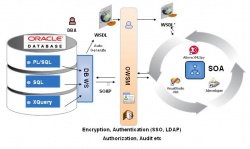WSDL
来自站长百科
(重定向自Wsdl)
WSDL 是 Web Services Description Language的缩写,是一个用来描述Web服务和说明如何与Web服务通信的XML语言。为用户提供详细的接口说明书。
WSDL简介[ ]
- WSDL是Web Service的描述语言,用于描述Web Service的服务,接口绑定等
WSDL的发展历史[ ]
WSDL的功能[ ]
- 怎样向别人介绍你的Web service有什么功能,以及每个函数调用时的参数呢?可能会自己写一套文档,甚至可能会口头上告诉需要使用的Web service的人。这些非正式的方法至少都有一个严重的问题:当程序员坐到电脑前,想要使用你的Web service的时候,他们的工具(如Visual Studio)无法给他们提供任何帮助,因为这些工具根本就不了解你的Web service。
- 解决方法是:用机器能阅读的方式提供一个正式的描述文档。Web service描述语言(WSDL)就是这样一个基于XML的语言,用于描述Web service及其函数、参数和返回值。因为是基于XML的,所以WSDL既是机器可阅读的,又是人可阅读的,这将是一个很大的好处。一些最新的开发工具既能根据你的Web service生成WSDL文档,又能导入WSDL文档,生成调用相应Web service的代码。
WSDL元素[ ]
- Type:使用某种语法(如 XML 模式)的数据类型定义(string、int)
- Message:要传递的数据
- Part:消息参数
- Operation:服务支持的操作的抽象描述
- Port Type / Interface:一个或多个端点支持的操作的抽象集。此名称已更改,因此可能会遇到两者中的任何一个。
- Binding:特定端口类型的具体协议和数据格式规范
- Port / Endpoint:绑定和网络地址的组合。此名称也已更改,因此可能会遇到两者中的任何一个。 Service:相关端点的集合,包括其关联的接口、操作、消息等。
WSDL文档结构[ ]
WSDL 文档是利用这些主要的元素来描述某个 web service 的:
- 元素 定义
- web service 执行的操作
- <message> web service 使用的消息
- <types> web service 使用的数据类型
- <binding> web service 使用的通信协议
- 一个 WSDL 文档的主要结构是类似这样的:
<definitions> <types> definition of types........ </types> <message> definition of a message.... </message> <portType> definition of a port....... </portType> <binding> definition of a binding.... </binding>
- </definitions>WSDL 文档可包含其它的元素,比如 extension 元素,以及一个 service 元素,此元素可把若干个 web services 的定义组合在一个单一的 WSDL 文档中。
- 如需完整的语法概述,请访问 WSDL 语法 这一节。同样要记住,与服务交互所需的所有细节都位于其 WSDL 文件中。
WSDL支持的消息交换方式[ ]
1)单向(One-way):服务端接收消息;
2)请求响应(Request-response):服务端点接收请求消息,然后发送响应消息;
3)要求应答(Solicit-response):服务访问端发送要求消息,然后接收应答消息。
4)通知(Notification):服务访问端点发送通知消息。
描述于 W3C 工作草案的完整 WSDL 1.2 语法[ ]
<wsdl:definitions name="nmtoken"? targetNamespace="uri">
<import namespace="uri" location="uri"/> *
<wsdl:documentation .... /> ?
<wsdl:types> ?
<wsdl:documentation .... /> ?
<xsd:schema .... /> *
</wsdl:types>
<wsdl:message name="ncname"> *
<wsdl:documentation .... /> ?
<part name="ncname" element="qname"? type="qname"?/> *
</wsdl:message>
<wsdl:portType name="ncname"> *
<wsdl:documentation .... /> ?
<wsdl:operation name="ncname"> *
<wsdl:documentation .... /> ?
<wsdl:input message="qname"> ?
<wsdl:documentation .... /> ?
</wsdl:input>
<wsdl:output message="qname"> ?
<wsdl:documentation .... /> ?
</wsdl:output>
<wsdl:fault name="ncname" message="qname"> *
<wsdl:documentation .... /> ?
</wsdl:fault>
</wsdl:operation>
</wsdl:portType>
<wsdl:serviceType name="ncname"> *
<wsdl:portType name="qname"/> +
</wsdl:serviceType>
<wsdl:binding name="ncname" type="qname"> *
<wsdl:documentation .... /> ?
<-- binding details --> *
<wsdl:operation name="ncname"> *
<wsdl:documentation .... /> ?
<-- binding details --> *
<wsdl:input> ?
<wsdl:documentation .... /> ?
<-- binding details -->
</wsdl:input>
<wsdl:output> ?
<wsdl:documentation .... /> ?
<-- binding details --> *
</wsdl:output>
<wsdl:fault name="ncname"> *
<wsdl:documentation .... /> ?
<-- binding details --> *
</wsdl:fault>
</wsdl:operation>
</wsdl:binding>
<wsdl:service name="ncname" serviceType="qname"> *
<wsdl:documentation .... /> ?
<wsdl:port name="ncname" binding="qname"> *
<wsdl:documentation .... /> ?
<-- address details -->
</wsdl:port>
</wsdl:service>
</wsdl:definitions>

